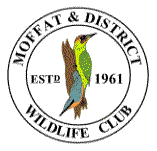Clicking
on any image will show a larger version. Use the 'back' button
of your browser to return to the page.
To
save having to scroll through the whole page, if you only
wish to see the latest information simple click
here.
A
Brief History
George &
Marion Paterson of Dyke Farm kindly made an area of land
available to Moffat & District Wildlife Club to allow
the creation of a Nature Reserve. This generous offer was
taken up and the club President, Emilio (Jock) Dicerbo immediately
set about planning how it would be developed. His foresight
has been taken forward to give us the small jewel we have
today.
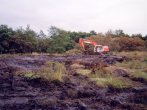 The
first steps, in 1999, involved digging two ponds. One, now
known as the Middle Pond, near the centre of the reserve,
and a larger, though mainly shallower, one that is now our
main wetland area - wide expanses of water with a number of
islands to provide safe havens for wildfowl. It may have looked
a muddy mess initially but vegetation growth soon hid the
scars! Within only a few years, they had become fully established
as waterfowl habitats. The
first steps, in 1999, involved digging two ponds. One, now
known as the Middle Pond, near the centre of the reserve,
and a larger, though mainly shallower, one that is now our
main wetland area - wide expanses of water with a number of
islands to provide safe havens for wildfowl. It may have looked
a muddy mess initially but vegetation growth soon hid the
scars! Within only a few years, they had become fully established
as waterfowl habitats.
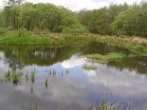
Middle Pond
|
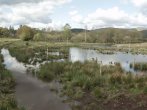
Main Wetland
|
The remainder
of the reserve was largely wet, soft ground, heavily covered
with Alder & Willow in various states of growth and
decay. This held small numbers of what we may regard as
typical garden birds.This was left largely untouched in
the early days.
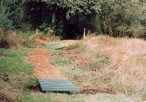 With
less than half the reserve being taken up by the ponds,
paths had to be created, various ditches had to be cleared
or dug and small bridges placed over them to allow access
to the rest of the reserve. The paths were basic but quite
functional - in fact it it was 2011 before some had deteriorated
to the extent that refurbishment was needed so they lasted
well. With
less than half the reserve being taken up by the ponds,
paths had to be created, various ditches had to be cleared
or dug and small bridges placed over them to allow access
to the rest of the reserve. The paths were basic but quite
functional - in fact it it was 2011 before some had deteriorated
to the extent that refurbishment was needed so they lasted
well.
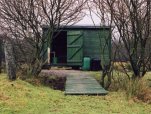
With good open views over the wetland, where the majority
of waterfowl could be seen, a hide was erected close to the
reserve entrance gate. Visitors could enter this hide watch
without disturbing the wildlife and get excellent views of
the birds on the wetland.
 With
the paths now reaching the woodland area, a further hide was
built in this area to allow visitors to view the small birds
present at close quarters. To the front and right It looked
over a boggy area with many fallen willow trees and, to the
left, to shrubby trees that suited the smaller birds. With
the paths now reaching the woodland area, a further hide was
built in this area to allow visitors to view the small birds
present at close quarters. To the front and right It looked
over a boggy area with many fallen willow trees and, to the
left, to shrubby trees that suited the smaller birds.
After
five years of work, the reserve was deemed to be a going concern.
Ever increasing numbers of birds, particularly waterfowl,
had either moved in or were dropping by - about 100 different
species had been recorded, a remarkable number! Additionally,
there was now a considerable variety of plants established
with an associated rise in insect species and our ponds proved
a boon to amphibians, damselflies & darters, while many
interesting, and occasionally quite rare, fungii were identified.
In June 2004 the Reserve was officially opened by Lady Johnstone.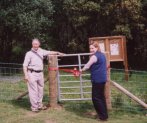

The Wildlife Club's President Emilio ('Jock') Dicerbo then
unveiled a plaque on the wetland hide and found, to his surprise,
that it had been named in his honour!
A
year later, in 2005, the boggy area immediately adjacent to
the woodland hide was finally cleared and a third pond created,
now called the Woodland Pond. Like the other ponds, this soon
became vegetated and, although similar in many ways to the
Middle Pond, it did develop somewhat differently. Moorhen
were quick to take advantage of it and damselflies, chasers
and darters were soon to follow. A 'dipping' session with
some of the local children in 2010 also found a very large
number of palmate newts had become established.
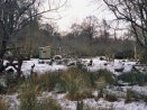
Cleared woodland before digging
|
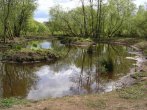
The new Woodland Pond nearly filled
|
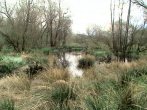
And once it became fully established
|
The
following years saw an immense increase in the vegetation.
Various general maintenance was carried out but circumstances
meant our merry band of volunteer workers had little time
available and it was impossible to keep pace. By 2010, the
reserve was becoming heavily overgrown. Our islands in the
wetland area had become heavily covered in rushes, trees,
bushes and other 'weeds'. They may have been pretty for humans
to look at but the waterfowl had stopped making use of them
(the ducks actually seemed to be avoiding them, preferring
to stick closer to the 'Jock's Hide' end of the wetland) and
they seemed to have no attraction to our smaller birds either.
Paths were beginning to show their age and plant diversity
was poor. A number of new tree species were planted by the
club to improve matters and a combined effort between the
club, MacMilllan Cancer Research and members of the public
increased the diversity immensely. The woodland area, almost
entirely Alder trees, had become extreme dense - like a forest
of telegraph poles with a heavy canopy giving rather a gloomy
understory - and there seemed to be a decline in the wildlife
within it. Both the Middle Pond and the Woodland Pond were
being hemmed in by trees and were now seldom visited by the
ducks or moorhen. To add to the woes, water plants had spread
extensively over all the ponds - the amount of open water
had diminished beyond that really needed for waterfowl to
use.
Fortunately,
things change and our volunteers found more free time so a
concentrated effort was started to try and restore the reserve
to its former glory and to make it more visitor friendly.
Although we all have other work to attend to, we have established
a regular pattern of working on Wednesday and Saturday mornings
from around 10.00am to about 1.00pm. Within these limitations,
we are doing what we can and there is no doubt that the purchase
of the best tools available has been a great investment, making
work quicker and easier. We also gained some new volunteers
so can achieve even more. The more volunteers we get the more
we can do. If you want to help, just come on down - we will
always find something that needs done!
Much
of the work is concurrent so the following summary is not
in chronological order!
The
overgown Woodland Pond was becoming hemmed in by the trees
around it. Waterfowl generally prefer an open approach (and
escape route) to open water. A number of trees were removed
to open up a corridor (or flight path) to connect the Woodland
Pond to the outside world. Interestingly, this new open space
seemed to hold some interest for our Robins and Tits too!
More trees were removed, first between the Woodland Pond and
the Middle Pond, then between the Middle Pond and the Wetland
to give a full flight corridor connecting all three of the
ponds. No sooner had this been done when, interestingly, some
Mallard were seen on the Woodland Pond for the first time
in a few years! The flight path leading to the outside was
later replanted with a few 'wildlife friendly' trees that,
when mature, will not reach any great height, so maintaining
a flight path.
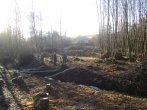
Corridor Woodland Pond to outside
|
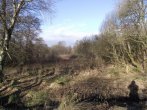
Corridor connecting all the ponds
|
Another
other project was to clear the islands in the main wetland
area in the hope that waterfowl and waders might start using
them again. From late 2010 to late 2011, with an interruption
during the breeding season, we made a start on the islands
we could reach easily. Lesser vegetation, such as rushes,
raspberry and scrub willow, was cut down.
While
many of the islands could be reached fairly readily, we made
the most of hard frost to reach others! With a good thickness
of ice we were able to get to them and made a good start.
But the ice didn't last long enough! Faced with getting to
islands with water 3ft deep, we opted to build a bridge.
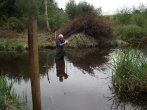
Garry lining up the bridge |
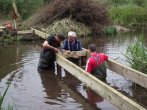
Supporting rails go in |
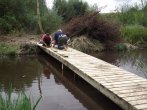
The last boards go on |
The
clearing of rushes, etc, was then completed and then the trees
removed.
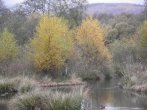
Pretty to look at - but not to the
wildlife! |
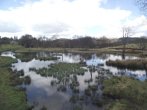
Starting 2013 with clean islands |
This was completed by early in 2013 and, while it may not
have improved the general appearance from a human point of
view, it suited the wildfowl and waders just fine - they were
back! Ducks and moorhen were soon clambering about and frequenting
the other end of the wetland again. The summer saw Canada
Geese returning to the islands after a two year absence and
they did attempt nesting.
The
plan is to gravel some of the islands to give suitable nest
sites for waders such as Oystercatcher (and a pair appear
to think about it even without the gravel but didn't stay).
Gravel has been obtained but the long tedious job of moving
it to the island is still to come! The bridge will help this
task immensely - but there is also a disadvantage in that
the bridge allows humans and predators easy access, not desirable
when birds are breeding so a future project is to provide
a lockable barrier to keep intruders out!
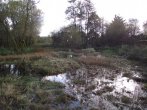 To
deal with the overgown ponds, a digger was brought in - this
was work that was beyond our capabilities. The image on the
left shows how choked the Woodland Pond had become - and the
Middle Pond was in a similar condition. Both these ponds were
dug out again to restore the open water. Waterfowl were happy
and, interestingly, during the summer of 2013 we saw far higher
numbers of damselflies and now dragonflies! The muddy banks
were quickly colonised by the usual weeds/wildflowers and
by the summer the scars were all hidden by a splendid display
of flowers. Nature is always quick to gain the upper hand
and 2013 has been an exceptionally good year for plant growth.
We will soon have to trim back the banks again! To
deal with the overgown ponds, a digger was brought in - this
was work that was beyond our capabilities. The image on the
left shows how choked the Woodland Pond had become - and the
Middle Pond was in a similar condition. Both these ponds were
dug out again to restore the open water. Waterfowl were happy
and, interestingly, during the summer of 2013 we saw far higher
numbers of damselflies and now dragonflies! The muddy banks
were quickly colonised by the usual weeds/wildflowers and
by the summer the scars were all hidden by a splendid display
of flowers. Nature is always quick to gain the upper hand
and 2013 has been an exceptionally good year for plant growth.
We will soon have to trim back the banks again!
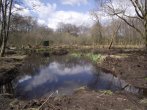
Woodland Pond in April |
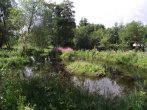
Woodland Pond in July |
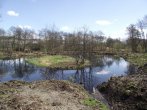
Middle Pond in April |
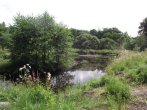
Middle Pond in July |
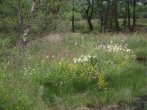
Middle Pond wildflowers |
The
wetland area was in a better state but still in need of attention
as some of the former channels had become totally engulfed
by plants and had reverted to (almost) dry land! We finally
obtained the services of another digger contractor in October
2013 and tackled the wetland, combining two of the islands
and opening up a good channel between this and the 'mainland'.
Mallard and moorhen started exploring almost immediately and
the mallard are now frequently seen in the new channel. The
opportunity was also taken to have the Sand Martin bank refaced,
in the hope that we will encourage the return of these lovely
wee birds, and the channel below it dug out to keep predators
at bay. Further digging operations are scheduled for around
the Middle and Woodland Ponds to improve the margins and manage
their drainage.
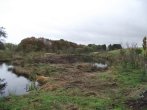
New island & channel
as seen from the north |
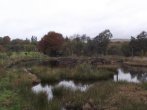
New island & channel
as seen from the hide |
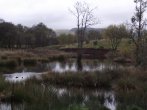
Refurbished Sandmartin Bank seen from
the hide |
The
woodland is now being thinned out - many of the alder trees
have two or more, even up to eight, trunks! By removing some
of the excess trunks and removing trees entirely where too
close to their neighbours, this should open up the woodland
allowing more light to reach ground level where, hopefully,
the plant diversity will improve. The remaining trees will
have more room to grow and soon 'bush up'.
The
general aspect is, as one person put it, "changing a
telephone pole forest back into a wood" and early signs
are that it is doing just that. Many of our smaller birds,
redstarts and flycatchers for example, do not like dense woodland
so hopefully they will appreciate the more open habitat and
return in their previous numbers.
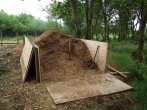 The
trees removed are not wasted. By hiring in a professional
'chipper', they provide a plentiful supply of woodchips that
can be used to refurbish the paths while logs that are too
big for chipping are used as edging. With such a copious supply
of such material, we can also considerably extend the path
network and, by using a good quality 'underlay', the new and
refurbished paths should last for many, many years with very
little maintenance beyond minor weed control and 'freshening
up' the surface chippings. The
trees removed are not wasted. By hiring in a professional
'chipper', they provide a plentiful supply of woodchips that
can be used to refurbish the paths while logs that are too
big for chipping are used as edging. With such a copious supply
of such material, we can also considerably extend the path
network and, by using a good quality 'underlay', the new and
refurbished paths should last for many, many years with very
little maintenance beyond minor weed control and 'freshening
up' the surface chippings.
Four seating areas, all of which now have picnic tables, have
been established to give our human visitors some nice places
to have a leisurely stop, especially if they came prepared
with flask and sandwiches! There are bird feeders close to
some of the tables so there should always be something to
see. We plan on introducing flowering and wildlife friendly
plants adjacent to these tables so, seasonally, there will
be even more to look at. The two on the eastern side also
allow splendid views out to the hills. A few simple benches
placed at intervals around the paths also provide good places
to sit and watch (or listen) during a walk around the reserve.
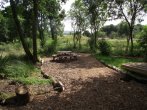
By work sheds |
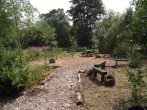
Beside Woodland Hide |
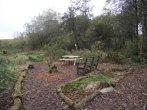
On the eastern side |
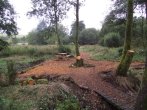
Beside the 'Big Ditch' |
A
few of the original bridges were deemed to be 'past it', although
not yet unsafe, and these have been replaced. Additionally,
some new bridges were placed across the main ditch - these
are mainly for the convenience of access during maintenance
work as there are currently no paths along the far side of
the ditch. A new path there is, however, planned for the future.
The 'squint bridge' in the woodland has also been replaced.
At the sluice (where the outfall from the wetland lies) there
was a makeshift bridge that was well beyond its safe life.
A new bridge has been built here, level with the top of the
banks, again with a view to having a good pathway along the
eastern side of the wetland area. This bridge is fully fitted
with handrails as there is a fair old drop to the outfall
level.
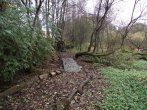
Woodland bridge |
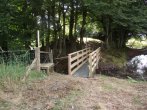
Sluice bridge |
During
the winter of 2013/14, with the persistent wet weather, our
progress has been hindered but we have been doing what we
can. Some additional water courses have been dug to reduce
some of the 'wet bits' on the footpaths (more to do) and numerous
nestboxes have been refurbished and/or replaced plus quite
a few new ones added. One of our islands has been resurfaced
with gravel and we hope Oystercatchers or other waders may
be tempted to nest on it.
Many
of the nestboxes were showing their age. These have all been
replaced and a good number of new ones added. We also did
the same for the boxes in adjacent properties where we were
permitted. There is now a very good selection of potential
nesting sites for our birds.
Various
strimming of islands and above the Sandmartin bank has been
done to give areas of short vegetation where ducks or geese
may wish to nest. A few new trees (holly & yew) have been
planted and there are many more to go in yet. Once better
weather (hopefully) arrives, we need a new shed/workshop put
up and quite a bit of digger work done around the ponds and
ditches.
Our
Sandmartin bank was suffering some erosion from wave action
so we have placed some boards along the bottom hoping to reduce
the problem and keep the bank viable for another year or two.
Some of the paths are now getting a new woodchip dressing
with the main 'circular' path has already done and others
will soon follow. We have a good supply of woodchips to keep
us going! With the prolonged wet weather, a few areas along
the path had become rather boggy and difficult to cross without
'wellies' on. These areas have been addressed to improve drainage
and are now more easily walked - visitors should now be able
to follow the entire circular walks without any special footwear!
The wet area near "Jock's seat" has been tackled
and a new path put through to the seats there. The original
path at the north end of the main pond has become untenable
due to mud, probably due to seepage from the pond, so we have
now fenced it off at both ends and will allow it to  'go
wild' - there is already a parallel path on the other side
of the ditch so there is still access along the north end
of the main pond, just a little further away. The outfall
pipe from the main pond, passing under the now discontinued
path, has been tidied up by creating a stone-lined water feature.
Looks much nicer than before and will look even better when
the plants regrow! 'go
wild' - there is already a parallel path on the other side
of the ditch so there is still access along the north end
of the main pond, just a little further away. The outfall
pipe from the main pond, passing under the now discontinued
path, has been tidied up by creating a stone-lined water feature.
Looks much nicer than before and will look even better when
the plants regrow!
With spring now
springing, we have done all we can do for the wildlife before
the breeding season comes around. We have achieved wonders
in completing good access for our human visitors. One new
footpath has been added, this one passing along the northern
edge of the Middle Pond. This should give some good views
of Damselflies once they are on the wing. With plenty of
woodchips still available, most paths are being topped up
with new chippings. A few other paths are planned but progress
will be determined by the need to avoid disturbance to nesting
wildlife. We have also moved our small storage shed to make
space for a new, bigger shed.
Few of us ever
get the chance to see what happens underwater in our ponds.
Jock has put a small tank in the woodland hide and has been
dipping the ponds to get some of our water beasties to put
in it - newt, stickleback and numerous nymphs of all sorts
(some nymphs are NOT included as, being fierce predators,
they would soon eat up everything else!). It is well worth
a long look to see these creatures and some nature 'in the
raw'.
All in all, our
reserve is looking good. Until the autumn, when we can undertake
more intensive work again, most of our efforts will be going
towards keeping up appearances with, hopefully, a few improvements
here and there.
We hope to find
time to add some new flowering/berry plants around the picnic
areas to make them more attractive. Wildflower seed has
been sown in a few areas already, should brighten things
up a bit. Limited time and manpower is always a problem
for us, of course. There is always plenty of work for us
to get on with as best as we can!
This page will
be updated at intervals as progress is made.....
Return to top of page
|
|
